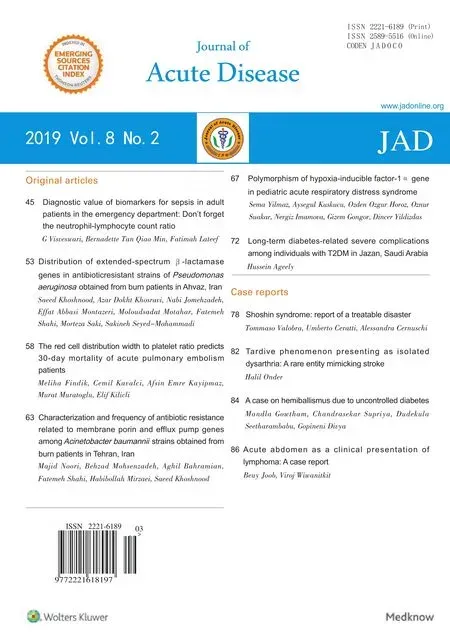Tardive phenomenon presenting as isolated dysarthria: A rare entity mimicking stroke
Halil Onder
Yozgat City Hospital, Department of Neurology, Yozgat, Turkey
Keywords:Tardive phenomenon Stroke Dysarthria Emergency department
ABSTRACT Distinguishing stroke mimics constitutes a considerable challenge for clinicians in emergency department. Here, we illustrate an extremely rare patient presenting with acute onset isolated dysarthria, who finally received diagnosis of tardive phenomenon associated with betahistine.Through the presentation of this case, we point out tardive phenomenon as an alternative differential diagnosis of stroke. Furthermore, this case adds substantial data presenting an interesting manifestation of isolated dysarthria as a tardive phenomenon, occurring due to betahistine usage which is extremely rare in literature.
1. Introduction
Distinguishing between stroke mimic and stroke may present a considerable challenge for clinicians in emergency departments. In clinical terminology, stroke can be defined as sudden onset of a focal neurological deficit conforming to a specific vascular distribution.However, there are several other circumstances that could mimic stroke and result in misdiagnosis, and could potentially lead to unnecessary and harmful treatments. It has been reported to range from 5% to 31% of these patients[1-7]. The most commonly reported stroke mimics are seizures, sepsis, toxic/metabolic disturbances,mass lesions, syncope, etc[1-6]. Nonetheless, although some forms of tardive phenomena may present with a rapid clinical onset, they are not generally considered as stroke mimics. In this paper, we report an extremely rare presentation of tardive phenomenon in a patient presenting with acute-onset isolated dysarthria who was finally diagnosed as tardive phenomenon associated with betahistine.
2. Case Report
The report was prepared in accordance with the Declaration of Helsinki. The patient’s consent form has been obtained. A-18-year-old female patient was admitted to emergency department due to acute-onset lisping. Her complaints had started abruptly and progressed over two hours prior to her admission to hospital.The neurological examination revealed normal findings other than dysarthria and mild oromandibular dystonia (Figure 1). Based on a provisional diagnosis of stroke, a cranial magnetic resonance imaging scan was performed and the result did not reveal any abnormal findings. However, upon history taking, it was learnt that the patient had been suffering vertigo, tinnitus and vomiting for two days prior to her admission to emergency department. She had been diagnosed as Meniere’s disease attack and had been taking betahistine dihydrochloride 24 mg twice daily and metaclopramide 10 mg tablets once daily (a total of 20 mg with the last dose 8 h prior to onset of the symptoms). Taken together, tardive phenomenon associated with the use of metoclopramide and betahistine dihydrochloride was considered in the forefront. She gradually recovered from dysarthria following intravenous hydration therapy.On evaluation sixteen hours later, dysarthria and dystonia were totally resolved (Figure 2). On the other hand, detailed interrogation of medical history yielded that the patient had taken metoclopramide multiple times due to previous attacks of Meniere’s disease, but no adverse events had occurred. However, considering that betahistine dihydrochloride usage was new, the etiological agent of these symptoms should be betahistine rather than metoclopramide.

Figure 2. Follow-up images showing totally recovery of dystonic dysarthria.
3. Discussion
Herein, we presented an extremely rare case of tardive phenomenon presenting with isolated dystonic dysarthria which had occurred in association with metoclopramide and betahistine dihydrochloride usage. Initially, a provisional diagnosis of stroke was made.However, normal cranial magnetic resonance imaging findings and a detailed interrogation of the progressive clinical symptoms enabled us to consider other diagnoses of stroke mimics. Finally, detailed interrogation of the medical history and total recovery of the clinic led to the diagnosis of tardive phenomenon. Remarkably, she had taken metoclopramide multiple times previously and no adverse effects had occurred, whereas the patient had taken betahistine dihydrochloride for the first time before this manifestation occurred.This rather suggested that betahistine dihydrochloride was the causative agent of tardive phenomenon in this patient. In the literature, tardive phenomenon associated with betahistine treatment has been reported extremely rarely[8,9]. Betahistine is known to have a strong H3 receptor antagonist activity[10-14]. Riu et al.[9] remarked the localization of histamine terminals and receptors in motor areas and emphasized previous reports mentioning association of histaminergic agents and antihistamine medication with dyskinesias.On the other hand, histaminergic agents have also been suggested to be efficient by indirectly modulating dopaminergic transmission[15].Via the presentation of this case, we add a remarkable sample of tardive phenomena to support the literature data regarding the association of betahistine and tardive phenomena, which was also in an atypical clinical picture, and in the form of acute onset isolated dysarthria. Future larger studies using functional neuroimaging methods are surely warranted to clarify the underlying pathophysiologies. Besides, this report also points out tardive phenomenon as an atypical differential diagnosis of stroke, giving crucial data for clinical approaches in emergency departments.To avoid unnecessary and potentially harmful treatments, tardive phenomena should be kept in mind in atypical presentations and medical history of suspected drugs.
Conflict of interest statement
The author reports no conflict of interest.
 Journal of Acute Disease2019年2期
Journal of Acute Disease2019年2期
- Journal of Acute Disease的其它文章
- Shoshin syndrome: report of a treatable disaster
- Long-term diabetes-related severe complications among individuals with T2DM in Jazan, Saudi Arabia
- Polymorphism of hypoxia-inducible factor-1α gene in pediatric acute respiratory distress syndrome
- Characterization and frequency of antibiotic resistance related to membrane porin and efflux pump genes among Acinetobacter baumannii strains obtained from burn patients in Tehran, Iran
- The red cell distribution width to platelet ratio predicts 30-day mortality of acute pulmonary embolism patients
- Distribution of extended-spectrum β-lactamase genes in antibioticresistant strains of Pseudomonas aeruginosa obtained from burn patients in Ahvaz, Iran
